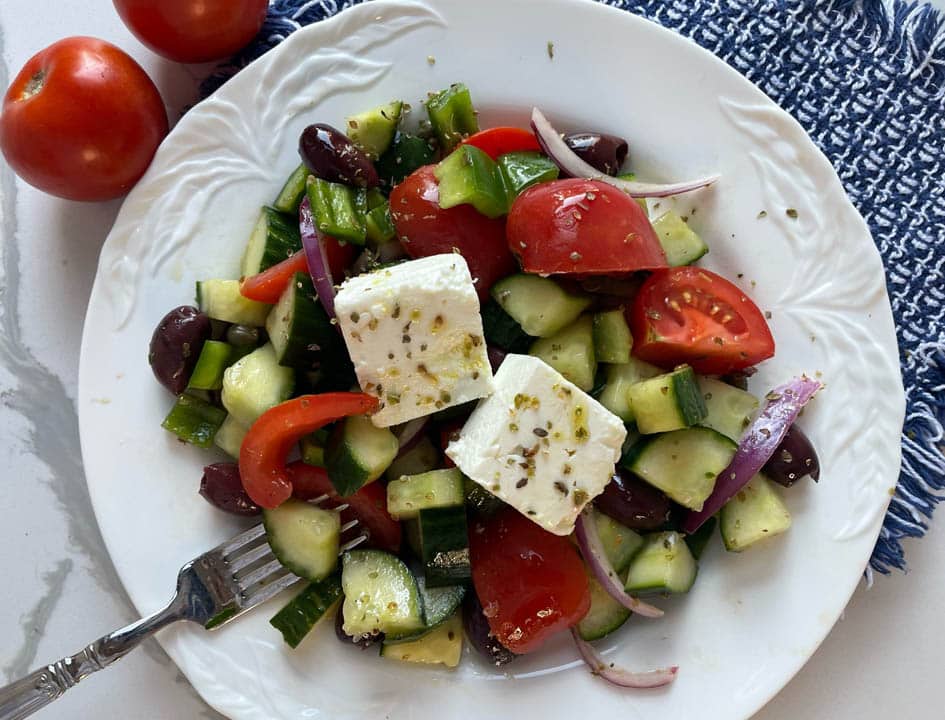written by:
Horiatiki Salata, the classic Greek Salad, is so good you may think you can’t make it at home. But you’re wrong. It’s an easy and tasty salad made from a few fresh ingredients.

Most of the technique of this salad is just chopping. And not even high-level chopping. This isn’t Michelin Star kitchen work. This is busy family kitchen work. You just need a large purple onion, an English cucumber, a green pepper, a tomato, some capers, kalamata olives, and feta cheese.
You might want to elevate this classic Greek salad ever so slightly by paying attention to the visual elements.
For instance, America’s Test Kitchen recommends you discard the head and foot of the green pepper in favor of uniform pieces. Slicing the onion from root to flower (pole-to-pole) is recommended for both the visual appeal and because it’s a lot easier.
Finally, you may be tempted to use fresh oregano (from that little potted plant you’ve been nursing over your sink) but don’t. Dried oregano imparts a different flavor profile than fresh, a more bitter taste that will make your Greek dressing authentic.
Table of contents
Ingredients for Classic Greek Salad
- 8 ounces of sheep’s milk feta cheese, cut into wedges
- 1 English cucumber quartered lengthwise, then chopped into half-inch pieces
- 2 fresh tomatoes
- 1 green bell pepper, for and head removed, chopped into half-inch pieces
- 1 small purple onion
- 2 tablespoons of capers, rinsed
- 1 cup of kalamata olives
- 1 generous teaspoon of dried oregano
- 1/4 cup top-quality extra-virgin olive oil, preferably a fruity Greek brand
- 3/4 teaspoon of salt, plus one teaspoon of salt
- ½ teaspoon of pepper
- 2 tablespoons of red wine vinegar
- Medium bowl of ice water
- Large salad bowl, small bowl
- Wire strainer
Instructions
- Slice the tomatoes in half, then into half-inch wedges, then slice the wedges in half for half-inch chunks
- Place tomato chunks into the colander over a bowl, sprinkle with a teaspoon of salt, toss, let sit for 30 minutes.
- Slice the onion in half from pole to pole, then slice into 1/8-inch slices in the same direction. Submerge all the slices into the ice water for 15 minutes.
- In a small bowl, combine the olive oil, vinegar, dried oregano, 3/4 teaspoon of salt, and pepper. Whisk.
- Combine all the vegetables into the main salad bowl (You may want to pat the tomatoes with a paper towel), drizzle with the vinegar dressing, drizzle with the olive oil mixture.
- Top with the feta cheese wedges.
- Serve in cold bowls.
Expert Tip for This Greek Salad Recipe
Submerging onions in an ice-water bath will change your salad game forever. It removes all the bitter flavors from onions, leaving the sweet behind—and leaves them nice and crispy. Not emulsifying the salad dressing not only makes this recipe easy, but it also divides the flavors throughout the salad, giving your diners a more varied taste experience.
FAQs About Greek Salad
No, Greek salad is all about chunky vegetables.
If you want to anger the gods, sure. Otherwise, no. The flavor of the olive oil is a key component of what makes a Greek salad Greek.
Sure. But it will be a slightly sweeter, different flavor profile and the overall texture of the salad will change. You may want to alter your chopping sizes to match, cutting the peppers smaller.
Serving Suggestion
This is a beautiful salad, so it’s a good choice for displaying in the middle of the table in a gorgeous white salad bowl or on a platter.
Storing leftovers
Greek salad stores well in a sealed container for up to three days. Because it doesn’t have lettuce, when you take it out of the refrigerator, you’ll have the same delicious salad from the day before with no wilted pieces. Be sure to give it a good mix, as all the liquids from the tomatoes and the dressing will have collected on the bottom of the container.
Print
Classic Greek Salad
Description
This version of the classic Horiatiki, or classic greek salad is an absolute unit of flavor. The ice-water trick in one of those chef’s secrets that will change your salad game. You’re welcome.
Ingredients
- eight ounces of sheep’s milk feta cheese, cut into wedges
- one English cucumber quartered lengthwise, then chopped into half-inch pieces
- two fresh tomatoes
- one green bell pepper, for and head removed, chopped into half-inch pieces
- one purple onion
- two tablespoons of capers, rinsed
- one cup of kalamata olives
- one generous teaspoon of dried oregano
- a quarter cup of top-quality extra-virgin olive oil, preferably a fruity Greek brand
- three-quarters of a teaspoon of salt, plus one teaspoon of salt
- half a teaspoon of pepper
- two tablespoons of red-wine vinegar
- a medium bowl of ice water
- large salad bowl, small bowl
- wire strainer
Instructions
- Slice the tomatoes in half, then into half-inch wedges, then slice the wedges in half for half-inch chunks
- Place tomato chunks into the colander over a bowl, sprinkle with a teaspoon of salt, toss, let sit for 30 minutes.
- Slice the onion in half from pole to pole, then slice into 1/8 inch slices in the same direction. Submerge all the slices into the ice water for 15 minutes.
- In a small bowl, combine the vinegar, dried oregano, 3/4 teaspoon of salt, and pepper. Whisk.
- Combine all the vegetables into the main salad bowl (You may want to pat the tomatoes with a paper towel), drizzle with the vinegar dressing, drizzle with the olive oil, mix.
- Top with the feta cheese wedges
- Serve in cold bowls
Notes
You’ll notice there’s no garlic in this recipe, which is weird because you just assume there’s garlic. However, a great trick is to halve a clove of garlic and rub the inside of your salad bowl all over. It adds the hint of garlic without adding the flavor or the ingredient, which doesn’t go in this salad but makes for a great addition to the overall bouquet.
© Photos/ Health Food Radar
The information provided on Health Food Radar is intended for general informational purposes only. While we strive to offer accurate and up-to-date content, we do not provide medical advice, diagnosis, or treatment. Always consult with a qualified healthcare professional before making any dietary or lifestyle changes, especially if you have underlying health conditions or concerns.


